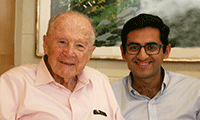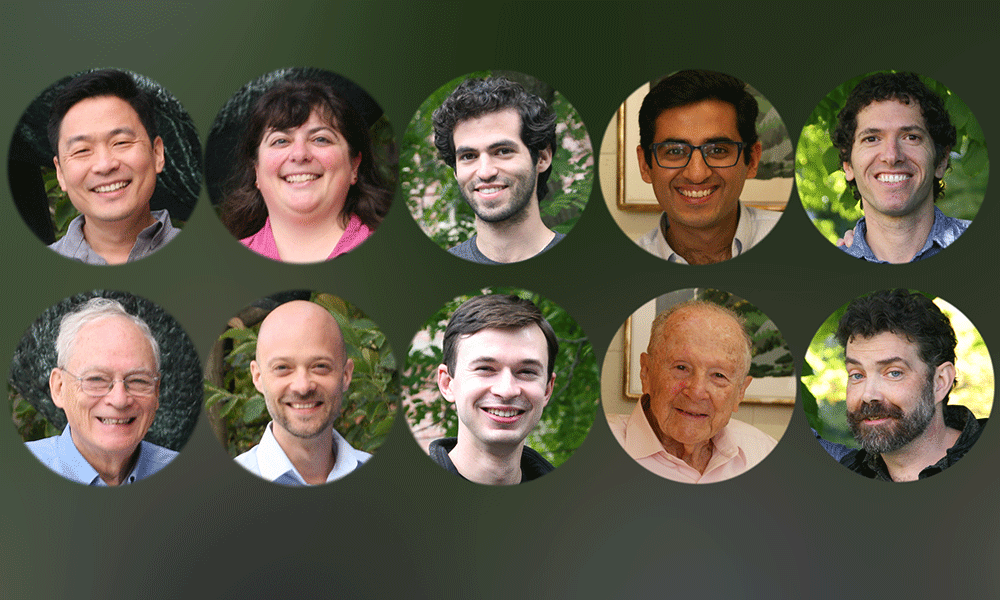Each fall, Harvard MCB holds a departmental research retreat, where incoming students can meet faculty and learn about the department’s research offerings. At this year’s retreat, MCB community members spent a weekend in Hyannis on Cape Cod. The festivities included an awards ceremony recognizing individuals’ extraordinary contributions to the MCB community.
The Björkman-Strominger-Wiley Prize for Collaboration

Ariel Amir (l) and Ethan Garner
Newly tenured MCB faculty Ethan Garner and Ariel Amir of Harvard SEAS and Applied Physics received the Björkman-Strominger-Wiley Prize for Collaboration.
The Björkman-Strominger-Wiley Prize highlights Harvard collaborations that advance the frontiers of science. Its name stems from a collaboration between MCB faculty Jack Strominger and Don C. Wiley (1944-2001) and then-graduate-student Pamela Björkman, who went on to become a professor at Caltech.
So far, their fruitful partnership has yielded three papers on how bacteria and archaea control their cells’ size and shape. The resulting studies have appeared in Nature Microbiology and eLife.
The prize committee cited the Garner-Amir collaboration as an example of how team-ups between experimentalists and theoreticians can yield both compelling experimental results and simplified models that support the central hypothesis.
The Doty-Losick Prize for Exceptional Service

(l to r) Ryan Draft, Rich Losick, Dominic Mao, and Laura Magnotti
The Doty-Losick Prize, named for MCB faculty Richard Losick and Paul Doty (1920-2011), honors people whose exceptional efforts to serve the MCB community far exceed their job descriptions. The 2019 Doty-Losick Award recognized Dominic Mao, Laura Magnotti, and Ryan Draft.
Mao and Draft serve as Assistant Directors for Undergraduate Studies in MCB/CPB and Neuroscience, respectively, and Magnotti is the Associate Concentration Advisor in Neuroscience. All three are instrumental in guiding undergraduates who pursue concentrations administered by the MCB department. They work with over 300 undergraduate students, assisting the students in course selection, finding placements in research labs, navigating thesis work, and applying for jobs.
In addition to their roles advising students and lecturing in courses, Mao, Magnotti, and Draft have all been active in organizing study abroad and volunteer initiatives in India. Draft is a point-person for the study abroad program in Bangalore, India; Magnotti recently taught a 3-week summer courses in Delhi and Bangalore; and Mao founded Program for Scientifically Inspired Leadership (PSIL), a program which hosts immersive science workshops for high school students in Manipur, India.
The Meselson Award for “Most Beautiful Experiment”

Matt Meselson (l) and Navish Wadhwa
Named for MCB faculty Matthew Meselson, the Meselson Award for “Most Beautiful Experiment” highlights individuals who have devised exceptionally elegant ways to test hypotheses. The 2019 Meselson Award honoree is postdoc Navish Wadhwa of the Berg Lab for his experiments exploring how bacterial flagella adapt varying loads.
“In Navish’s experiments the bacterium is anchored to a surface via its flagellum, causing the entire bacterium to rotate,” a nominator wrote. “That is not new. What is new is the application of a fast-rotating electric field to control the amount of torque; at high rotations of the field the load on the bacterium and hence the flagellum is reduced to zero. Thus, Navish could both increase and decrease the load over a wide range…Using theory and new technology, Navish achieved a beautiful demonstration of the concept that a bacterial motor elegantly adapts to an environmental cue, the load on the flagellum, to adjust the number of motor units both with increasing and decreasing loads. ”
The award’s name traces to an experiment Meselson and his colleague Franklin Stahl conducted in 1958. The experiment validated the proposed double helix structure of DNA and demonstrated that DNA replicates semi-conservatively. It has been repeatedly called “the most beautiful experiment in biology.” Meselson awardees represent Harvard researchers who continue that tradition of elegant experiments.
The Peralta Graduate Student Essay Award

James Valcourt (l) and Javier Masis
This year’s Peralta Graduate Student Essay contest resulted in a tie, honoring MCO graduate student Javier Alejandro Masís (G7) of the Cox Lab and Systems Biology graduate student James Valcourt (G6) of the Ramanathan Lab.
The award honors the memory of MCB faculty Ernest Peralta (1959-1999), who was a dedicated teacher and communicator of science. The Peralta Prize contest encourages graduate students in MCB labs to write essays that communicate their thesis topic to a general audience in about 1,000 words.
MCB faculty chose the two winning essays based on their clarity, scientific significance, and writing style.
Masís’ essay—titled “What makes a good learner?”—describes a learning dilemma faced by rats and humans alike. When learners encounter a new problem, they could rapidly gain rewards by guessing quickly and randomly, or they could spend more time on the problem, reducing the number of instant rewards but earning greater rewards over the long term. “We found that rats slowed down at the beginning of learning, sacrificing present rewards, in order to learn faster, and get a higher reward rate sooner,” he wrote. “We replicated our results by training the rats on new objects they had never seen before and found that they slowed down again at the beginning of learning, and went back to their typical speeds once they were done learning.”
Valcourt’s essay is called “Commitment Issues: How Do Human Stem Cells Commit to a Lineage During Development?” and deals with the signals that guide stem cells. Early on, stem cells can give rise to any cell type, but, after receiving numerous signals from the surrounding environment, they are said to be “committed,” or locked into becoming a particular cell type. “Committed and non-committed cells are visually indistinguishable,” Valcourt explains in his essay. However, Valcourt and his collaborators were able to come up with another way to identify committed and uncommitted cells. They attached two differently-colored fluorescent markers to two proteins, OCT4 and SOX2. “Just by looking at the ratio of red to green fluorescence coming from an individual cell, we could almost perfectly predict what that cell was going to do in response to the signal,” Valcourt writes. “We finally had our window into the thinking of the moody teenager that is the differentiating cell.”
Congratulations to all the departmental retreat award winners!


